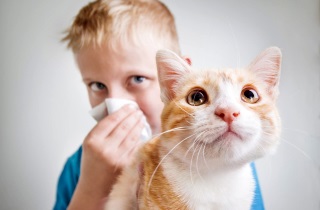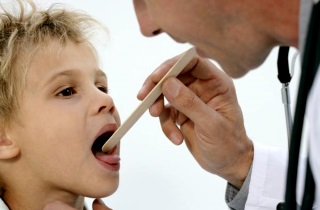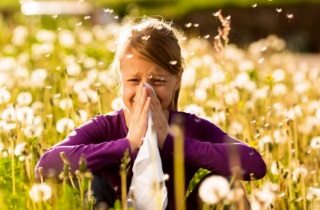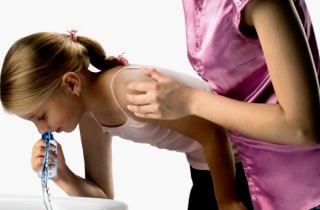Purulent mucus at the back of the throat. Causes of mucus draining into the nasopharynx
Children often get colds; this is absolutely normal for an organism with an undeveloped immune system. However, in some cases, illnesses are tolerated relatively easily, and sometimes they have very alarming symptoms. Excessive accumulation of mucus in the nose and its flow down the back wall nasopharynx in the throat is a reason to contact an otolaryngologist.
What is posterior rhinitis?
Spores flowing down the back wall of the throat are called nasopharyngitis. The concentration of mucus in such an unusual place is due to the fact that the infection affects not only nasal cavity, but also the nasopharynx, pharyngeal ring and the back wall of the pharynx. Exactly because of this reason nasal breathing The child rarely experiences difficulties; he is more worried about the following symptoms:
- runny nose that cannot be blown;
- reflex cough;
- nausea, vomiting;
- feeling of a lump in the throat;
- difficulty swallowing food;
- increased body temperature;
- lack of appetite;
- bad breath.
Snot in the nasopharynx in a child infancy- a real problem, because babies cannot suckle normally, they have to constantly be distracted to take a breath. Coughing most often bothers babies at night, as snot flows down the throat and irritates the cough reflex receptors. In this case, the patient’s bronchi and alveoli will be clean.
Most unpleasant symptom- nausea. It is in the pharynx that there are a large number of vomiting receptors, which are irritated by flowing mucus. This can lead to the child completely refusing to eat.
Reasons for violation
Posterior nasopharyngitis may indicate the presence serious illnesses in the child’s body, but it may also be a simple protective reaction of the body to unfavourable conditions environment. Snot flowing down the back wall most often develops against the background of viral diseases. Less common are bacterial and fungal infections, allergies.
 Causative agents of posterior rhinitis:
Causative agents of posterior rhinitis:
- dust, tobacco smoke, animal dander and other allergens;
- insufficient room humidity;
- too much heat air in the room;
- viral diseases (rhinoviruses, coronaviruses);
- fungal infections;
- bacterial infections (streptococci, staphylococci);
- measles, rubella, scarlet fever.
Determining the root cause of the violation is very important for prescribing proper treatment. A runny nose itself cannot be cured; it will only go away if the disease that caused it can be eliminated. Diagnosis is carried out by an otolaryngologist by examining the child and studying test results.
Possible complications
When mucus runs down the back of the throat, the baby experiences severe discomfort. Available complete failure from food and weight loss, but this is not scary, all the kilograms can be gained within 3-4 days after the end of the illness. Children sleep little because they are bothered by coughing, which causes stress and irritability.
Unpleasant sensations are not all that snot that flows down the back of the throat is fraught with. If you do not treat the cause in time, you may be affected Airways and gastrointestinal tract, this can lead to the development of pneumonia, bronchitis, asthma, sore throat, and indigestion.
Clean air is the key to recovery
 Experienced pediatricians do not recommend starting treatment with antibiotics, vasoconstrictor drops and sprays, as this can only harm the baby. It is much more useful to provide the child with conditions favorable for recovery. To do this, you need to take care of the air he breathes. Fast treatment will facilitate the adoption of the following measures:
Experienced pediatricians do not recommend starting treatment with antibiotics, vasoconstrictor drops and sprays, as this can only harm the baby. It is much more useful to provide the child with conditions favorable for recovery. To do this, you need to take care of the air he breathes. Fast treatment will facilitate the adoption of the following measures:
- Regular ventilation of the room. In the room where the child is sick, a huge number of pathogenic organisms are concentrated. Take the baby out 2-4 times a day and open the window for 10-15 minutes.
- Air humidification. Too dry air causes the snot to dry out and become a lump in the throat, making it impossible to remove it at all. To prevent this from happening, monitor the humidity in the room; the indicator should not be lower than 60-70%. If you cannot buy a household humidifier, spray water from a spray bottle, hang wet towels, wash the floors several times.
- Setting the optimal temperature. The child will not recover faster if you arrange tropics in his room; on the contrary, this will worsen his condition. The optimal temperature is 18-20ᵒ C. Dress your baby in warm pajamas and wrap him in a warm blanket, but do not overheat the air, this is harmful to the nasopharyngeal mucosa.
Treatment methods
 Medications are used only in as a last resort as prescribed by a doctor. It is best to take measures that will help alleviate the child’s condition and quickly overcome the infection. The following treatment methods are suitable for this:
Medications are used only in as a last resort as prescribed by a doctor. It is best to take measures that will help alleviate the child’s condition and quickly overcome the infection. The following treatment methods are suitable for this:
- Washing. The nose should be washed as often as possible to disinfect the throat mucosa. To do this, use an infusion of chamomile, sage, oak bark, a solution sea salt and furatsilin. You can also buy it at the pharmacy ready-made mixtures, for example, “Aqua-Maris”, “Aqualor”, they have a moisturizing and thinning effect.
- Rinsing. Gargling is also very useful, since this is where the source of infection is concentrated. The procedure can be carried out using medicinal decoctions and infusions. You can also prepare a mixture of sea salt and soda yourself; if your child is not allergic to iodine, add a couple of drops to the liquid.
- Moisturizing the mucous membrane. Olive, sea buckthorn and peach oils have excellent moisturizing properties. They envelop the mucous membranes with a thin film, preventing them from drying out. There will also be useful addition in oils of vitamins A and E.
Preventive measures
 Mucus that flows down the back wall of the nasopharynx is a sign of weakened immunity. The disorder itself and the diseases that provoke it are easier to prevent than to treat. To do this, you need to take all measures to strengthen local and general immunity.
Mucus that flows down the back wall of the nasopharynx is a sign of weakened immunity. The disorder itself and the diseases that provoke it are easier to prevent than to treat. To do this, you need to take all measures to strengthen local and general immunity.
Children who have problems with tonsils or adenoids need to organize trips to salt rooms. It is important to monitor humidity levels and temperature conditions in the baby's bedroom all the time, and not just when he is sick. Dress it according to the weather and go for walks more often fresh air, it is good for the body.
The child’s diet should also be approached responsibly. If the baby has food allergy, exclude from the menu all dishes and components that can provoke an exacerbation.
Try to give more vegetables and fruits; vitamins in their natural form are better absorbed by the body. If age permits, it is advisable to enroll children in sport sections, it also has a beneficial effect on health.
Let's sum it up
 Posterior rhinitis can occur due to the most various reasons. Treatment depends on what disease caused it, because a runny nose is not a pathology, but only a consequence. Correct diagnosis can only deliver experienced doctor, sometimes to compile a complete clinical picture Additional tests and consultations with different doctors are prescribed.
Posterior rhinitis can occur due to the most various reasons. Treatment depends on what disease caused it, because a runny nose is not a pathology, but only a consequence. Correct diagnosis can only deliver experienced doctor, sometimes to compile a complete clinical picture Additional tests and consultations with different doctors are prescribed.
The problem should not be ignored under any circumstances, because neglected conditions can lead to serious complications and development chronic diseases. However, start right away drug therapy with potent drugs also not worth it. It is important to create ideal conditions so that the child’s body can fight off the infection itself.
Inflammatory process in the respiratory tract provokes the development of many diseases. The patient may complain of mucus running down the back of the throat. This phenomenon may occur against the background various diseases. IN medical practice This is postnasal drip. How to get rid of this unpleasant symptom?
The formation of mucus in the nasopharynx is a protective reaction against pathogens, bacteria, and viruses. When it enters the body through the respiratory tract, a viscous secretion is produced in the nasopharynx, which prevents further penetration of pathogenic microflora.
If mucus is produced in large quantities, then begins to flow down the walls of the larynx into the bronchi, causing discomfort. Draining mucus in the nasopharynx may be associated with diseases of the ENT organs such as:
- (bacterial or viral)
Abnormalities in the structure of the nasopharynx, enlargement, and rhinitis during pregnancy can contribute to the appearance of mucus on the back of the throat. The inflammatory process in the nasopharynx is always accompanied by an accumulation of mucus. In addition, inadequate treatment of rhinitis, sinusitis and other diseases of the nasopharynx provokes the appearance of mucus and its drainage.
More information about postnasal drip can be found in the video:
The formation of mucus can be observed with problems of the digestive system: laryngopharyngeal reflux and esophageal diverticulum.Another equally common reason for the development of postnasal drip is the uncontrolled use of vasoconstrictors.
Danger signs: when you need a doctor
Depending on the position of the body, the intensity of the symptom appears. If a person is in horizontal position, then drains and enters the epiglottis. In this case, the receptors are irritated and it occurs. IN vertical position the person swallows the mucus without coughing.
The patient may feel a feeling of mucus accumulation, itching and burning in the nasopharynx, and a lump in the throat.
The mucus may be transparent or yellow-green in color, and it can be felt putrid smell from mouth. Along with this, you may experience: headache, weakness.
Most often, these symptoms appear in the morning, and coughing occurs at night.If the above symptoms are observed within 1-2 weeks, then you must definitely consult a doctor who will prescribe effective and adequate treatment.
Drug treatment

When contacting, the doctor will examine the nasopharynx and, if necessary, prescribe lab tests and bacteriological culture of mucus from the throat.Before starting treatment, you need to determine the cause of mucus formation.
Features of treatment:
- If the accumulation and drainage of mucus occurs against the background of ARVI, then antiviral drugs are prescribed.
- For rhinitis of a bacterial nature, antibacterial drugs are used.
- If the runny nose is of an antibacterial nature, then antibiotics are prescribed local action: Isofra, Polydexa. It is also possible to use anti-inflammatory and antiseptic drugs.
- To improve mucus expectoration, mucolytics are prescribed: Fluditec, etc.
- Rhinitis allergic nature eliminated with antihistamines: Flixonase, Nazonex, Cromohexal, Claritin, etc.
Symptomatic treatment involves rinsing and inhalation. You can rinse your throat with a solution of potassium permanganate, furatsilin, sea salt. Among the preparations for the procedure, you can use Marimer, Humer, etc.Inhalations facilitate easy expectoration of snot without irritating the throat.
During treatment, you should drink plenty of fluids - this will help thin the mucus and help prevent dehydration.
Maybe surgical intervention, if the cause of postnasal drip is a deviated septum, the presence of polyps and other anomalies.
If the cause of the formation and accumulation of mucus is related to digestive system, then the gastroenterologist will prescribe drugs that block the production of hydrochloric acid. Patients should also not eat food a couple of hours before bedtime and give up bad habits.
Traditional methods

At home you can use traditional methods for elimination this symptom. However, it should be remembered that unconventional methods are unable to eliminate the cause of this phenomenon.
Popular recipes for better mucus discharge:
- Aloe with honey. Dilute aloe juice with water in equal quantities and add a little honey. Place in each nasal passage.
- Inhalations with. Add 2 large spoons of propolis to 0.5 liters of boiling water. You can add a few drops of lavender or rosemary essential oil. Cover your head with a terry towel and breathe in the steam for several minutes.
- Honey with lemon. Warm in a glass boiled water dissolve a teaspoon of honey and lemon. Stir and consume in small sips.
- A decoction of turmeric and ginger. Brew regular tea in a glass, add equal amounts of ginger, turmeric and a teaspoon of honey. Stir the tea well and take in small portions.
- It is very effective to rinse your throat and nose at home if mucus begins to accumulate. Can be used saline solution, soda with a few drops of iodine added, decoctions medicinal plants(, oak bark, etc.)
Traditional methods of treatment for mucus drainage should be used with caution by people prone to allergic reaction, and also if mucus forms against the background of allergic rhinitis.
Prognosis and complications
![]()
A cough in a child can be caused not only by an infection in the throat, but also by snot accumulated there. They flow down the back wall of the larynx, and the baby begins to choke and cough. If you do not take action in time and do not get rid of this problem, bronchitis and even bronchial asthma. And the constantly present mucus in the nasopharynx is a real breeding ground for infection, which can cause sinusitis or otitis media.
Causes of mucus accumulation
Before you start treating thick snot running down your nasopharynx, you need to find out as accurately as possible what caused their appearance. If you break everything possible reasons into groups, they can be: allergic, non-infectious and infectious. But we won't do detailed classification, but we will only list those for which they appear most often:

The baby has another additional reason related to physiological characteristics. A lot of saliva and mucus are released during active teething. During this entire period, care must be taken to ensure that the child’s head is not thrown back, especially during sleep. No treatment in in this case will not help, you just need to wait out this time.
Home treatment
If they appear in a child recently and do not have a pronounced green, yellow or orange color, indicating a large number of pathogenic microorganisms, then you can try to cure them with home methods. Verified folk remedies absolutely safe, and initial stage even viral disease sometimes no less effective than pharmaceutical drugs.
 Treatment should begin with thorough rinsing of the nose. This can be done with a solution of sea salt (1 tsp per glass of water), chamomile decoction, furatsilin. Before rinsing, you should try to remove snot from your nose by blowing it out or pulling it out with an aspirator.
Treatment should begin with thorough rinsing of the nose. This can be done with a solution of sea salt (1 tsp per glass of water), chamomile decoction, furatsilin. Before rinsing, you should try to remove snot from your nose by blowing it out or pulling it out with an aspirator.
Older children can inhale water on their own by closing one nostril. For babies it can be given from a syringe without a needle or a soft small syringe. The head should be tilted down, and the water pressure should not be too high so that snot does not get into your ears.
After rinsing the nose, you need to put some drops in it. You can use the following as drops:

Home inhalations with decoctions of the herbs listed above or potato steam give a good effect. If you don’t have an inhaler, you can sit the child over a bowl of broth, cover his head with a towel (not completely, leave access to air!) and let him breathe for 5-10 minutes.
Drug therapy
If home methods do not help, and snot continues to accumulate on the back of the throat, then two options are possible: they have non-infectious cause and we need to look for it urgently, or the disease will develop and will have to be connected. A doctor should prescribe such treatment, taking into account age and general physical condition child.
Many mothers try to treat snot on the back wall of the nasopharynx vasoconstrictor drugs. In most cases, they are ineffective, and sometimes even aggravate the problem, as they greatly dry out the mucous membranes.
In addition, they have a number of contraindications. Therefore, we strongly recommend that you consult your doctor before using them.
Excellent medicine is natural pharmaceutical drug"Pinosol." It is based on plant and essential oils, which perfectly help relieve inflammation of the nose and throat, have quite strong antibacterial properties. The medicine envelops the nasal mucosa and lingers on the back wall of the nasopharynx, creating a protective film.
